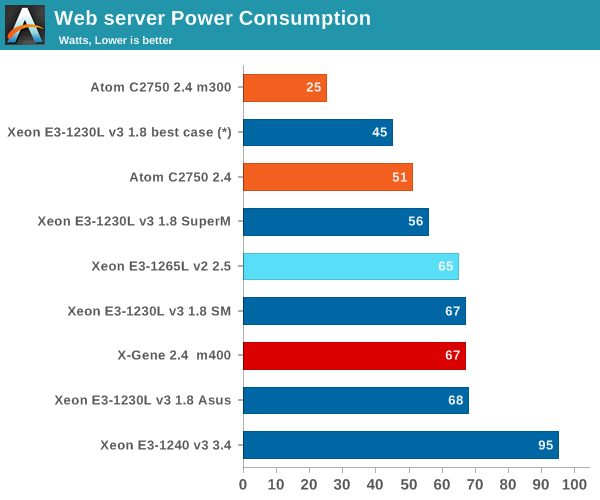X-Gene 1, Atom C2000 and Xeon E3: Exploring the Scale-Out Server World
by Johan De Gelas on March 9, 2015 2:00 PM ESTWeb infrastructure Power consumption
Next we tested the system under load.

(*) measured/calculated to mimic a Xeon-E3 "m300-ish" board.
Notice how much difference there is between a feature rich motherboard and a micro server cartridge. The ASRock board consumes about twice as much as the HP m300 cartridge and the Supermicro node is in between. In both cases the cost of cooling is not included. Of course, we should not compare the ASRock board and the m300 cartridge directly as they target different markets, but it shows that the energy efficiency of a scale-out server infrastructure depends a lot on the server chassis used. HP's Moonshot really nailed it.
Power efficiency is not the forte of the X-Gene at the moment. The Xeon E3-1230L v3 is able to outperform it by a large margin and consumes a lot less power in the process. Even in combination with our most feature-rich boards such as the ASUS P9D-MH, a Xeon E3-1230L v3 does not consume more than an X-Gene with a much more efficient cartridge.










47 Comments
View All Comments
IBleedOrange - Monday, March 9, 2015 - link
EETimes is wrong.Google "Intel Denverton"
beginner99 - Monday, March 9, 2015 - link
Maybe it would be good to mention the X-Gene is made on a 40nm process at the start of the article. I read the article and think for myself that the X-Gene is crap and in the end you get the explanation. It's on 40 nm vs Atoms on Intel 22 nm. It's a huge difference and currently the article is a bit misleading eg. shining a bad light on X-Gene and ARM. (And I say this even though I always was a proponent of Intel Big cores in almost all server applications).Stephen Barrett - Monday, March 9, 2015 - link
If APM had a newer part to test then we would have tested it. XG2 is simply not out yet. So the fact that APM has their flagship SoC on an older process is not misleading... Its the facts. The currently available Intel parts have a process advantage.warreo - Monday, March 9, 2015 - link
Mentioning it at the start would be good from a technical disclosure standpoint, but I'm not sure for the purposes of this article it truly matters. The article is comparing what is currently available now from APM and Intel. Reality is Intel will likely have a significant process advantage for the foreseeable future, and if you wanted to see a like for like comparison on a process basis, then you'll probably need to wait 2-3 years for X-Gene to get on 22nm, meanwhile Intel will have moved on to 10nm.CajunArson - Monday, March 9, 2015 - link
The 40nm process is only really relevant when it comes to the power-consumption comparisons.A 28nm.. or 20nm or 16nm... part with the same cores at the same clockspeeds will register the exact same level of performance. The only difference will be that the smaller lithographic processes should provide that level of performance in a smaller power envelope.
JohanAnandtech - Monday, March 9, 2015 - link
well, with so much time invested in an article, I always hope people will read the pages between page 1 and 18 too :-p. It is mentioned in the overview of the SoCs on page 5 and quite a few times at other pages too.colinstu - Monday, March 9, 2015 - link
what server is on the bottom of the first page?JohanAnandtech - Monday, March 9, 2015 - link
A very old MSI server :-). Just to show people what webfarms used before the micro server era.Samus - Monday, March 9, 2015 - link
I use the Xeon E3-1230v3 in desktop applications all the time. It's basically an i7 for the price of an i5.And a lot of IT dept dump them on eBay cheap when they upgrade their servers. They can be had well under $200 lightly used. The 80w TDP could theoretically have some drawbacks for boost time, but the real-world performance according to passmark elongated tests doesn't seem to show any difference between it's boost potential and that of an 88w i7-k
Great CPU's.
Alone-in-the-net - Monday, March 9, 2015 - link
In both your compilers, you need to specify the -march=native so the the compiler can optimize for the architecture you are running on, -o3 is not enough. This enables the compiler to use cpu specific commands.